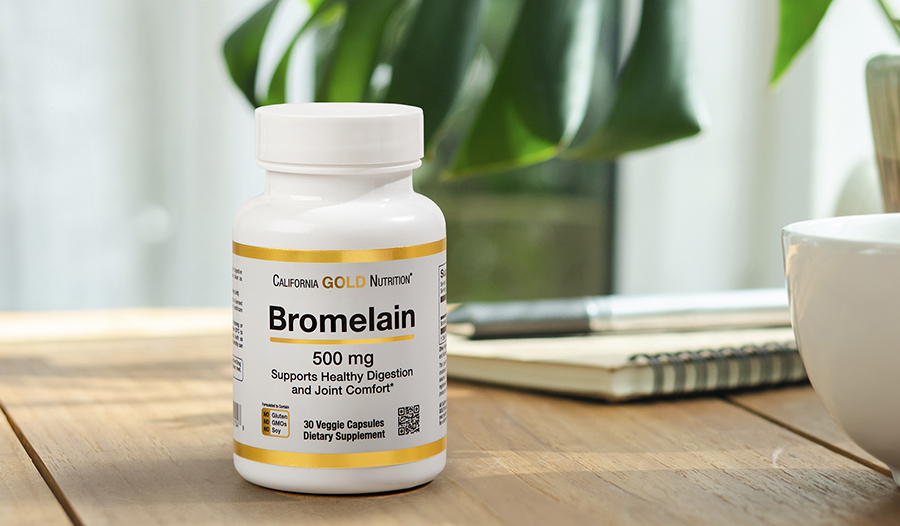6 Health Benefits of Bromelain + Food Sources, Forms, and Side Effects
DISCLAIMER:This blog does not intend to provide diagnosis...
- In this article:
- What Is Bromelain?
- What is Bromelain Used For?
- Bromelain and Sports Injuries
- Bromelain and Recovery from Surgery
- Bromelain and Joint Health
- Bromelain and the Respiratory Tract
- Bromelain and Immune Function
- Bromelain in Varicose Veins and Vein Inflammation
- Available Forms of Bromelain
- Side Effects

What Is Bromelain?
Bromelain is a group of sulfur-containing enzymes obtained from the pineapple plant. Bromelain supplements are produced from the stem of the pineapple plant, which differs from the bromelain derived from the fruit.1
The research and benefits of bromelain almost exclusively refer to the bromelain derived from the stem, introduced as a dietary supplement in 1957. Since then, more than 300 scientific papers on its beneficial effects have appeared in the medical literature.
What is Bromelain Used For?
While bromelain can be helpful as a digestive aid, it has been used primarily to help support recovery from injury, sprains, strains, arthritis, surgery, and other physical trauma. Bromelain is also helpful in supporting the body's recovery from inflammation, a well-documented effect in various experimental models and clinical studies.2
Bromelain works primarily by stimulating the production of plasmin, a compound that blocks the formation of pro-inflammatory compounds and breaks down fibrin—a substance that promotes swelling, inflammation, and scar formation.3 Via a separate mechanism, bromelain has also been shown to reduce the production of compounds known as kinins.4 These compounds cause much inflammation, swelling, and pain after traumatic injuries (like sports injuries).
Bromelain and Sports Injuries
Clinical studies have shown bromelain is effective in a variety of sports-related injuries. One of the most exciting studies was a 1960 study involving boxers.5 The group receiving the bromelain experienced a quicker resolution of their facial injuries. Fifty-eight of seventy-four boxers receiving bromelain reported that all signs of bruising had entirely cleared within four days. Of the remaining sixteen, complete clearance took 8 to 10 days. In contrast, of the seventy-two controls, only ten showed bruises wholly cleared at the end of 4 days, the remainder taking 7 to 14 days.
Bromelain and Recovery from Surgery
The ability of bromelain to reduce swelling, bruising, healing time, and pain following surgical procedures has been demonstrated in numerous clinical studies. Bromelain has shown to be particularly useful in recovery from dental surgeries, such as wisdom tooth extraction.6 In the latest study, bromelain was compared to standard drug therapy (aceclofenac) after removing an impacted wisdom tooth.7 The primary outcome variables were pain, swelling, and trismus (lockjaw) evaluated on postoperative days 2 and 7. Bromelain outperformed aceclofenac in reducing the severity of swelling and trismus and demonstrated similar pain relief. The researchers concluded, "The present study showed that the efficacy of bromelain was comparable to that of aceclofenac in reducing inflammatory complications following surgical removal of impacted mandibular third molars."
Bromelain and Joint Health
Bromelain exerts several beneficial effects in supporting joint health, especially in osteoarthritis (OA), a degenerative disorder of joints caused by the breakdown of cartilage and other joint compounds. Bromelain helps support healthy joints by protecting the health of cartilage through decreasing oxidative stress and the genetic expression of compounds that trigger inflammation and pain.8 Clinical studies with bromelain and other proteolytic enzymes showed improved joint function, range of motion, and reduced discomfort.9
Bromelain and the Respiratory Tract
Bromelain exerts several effects that benefit the health of the respiratory tract. For example, bromelain reduces respiratory tract secretions' viscosity (thickness and stickiness). This helps improve lung capacity and function and suppresses coughs and bronchial irritation. It also helps with nasal and sinus congestion.10-12
Bromelain and Immune Function
Bromelain exerts very complex effects on immune function.2 While an overstimulated immune system can cause inflammation and damage, an underactive immune system can increase infection risk.
Bromelain's effect on immune function is related to the direct impact on white blood cells. Still, more profound levels of control on molecular signaling pathways and gene expression involved in the immune response are likely more critical in its regulatory effects. Bromelain promotes proper immune system functioning and preservation of homeostasis (balance). Depending on the environment of the cell and the general state of function, bromelain may cause both an increase and a decrease in the activity/expression of the same molecules involved in the immune response.
One of the effects of bromelain to help fight an overactive immune system is decreasing the migration of white blood cells (WBCs) to areas of inflammation. Adding more WBCs to an inflamed area is like throwing gas on a fire. Bromelain helps prevent the worsening of the inflamed and swollen area.13
In terms of activating the ability of the immune system to fight infection, bromelain enhances WBC function directly and "primes" WBCs to respond to signaling molecules like interferon—the body's innate antiviral compound.14,15 bromelain enhances both the innate (nonspecific) immune system and the adaptive (specific) immune response and white blood cell function.
Bromelain in Varicose Veins and Vein Inflammation
Bromelain has been shown to exert a favorable effect when a vein is inflamed. Specifically, bromelain has been shown to reduce discomfort, swelling, redness, tenderness, elevated skin temperature, and disability when used at 500 to 750 mg daily.
Bromelain may also help improve the appearance of varicose veins. Individuals with varicose veins have a decreased ability to break down fibrin, a scar-like protein. When fibrin is deposited in the tissue near the varicose veins, the skin then becomes hard and "lumpy." Bromelain helps this situation because vein walls are an essential source of plasminogen activator, which promotes the breakdown of fibrin. Bromelain acts similarly to plasminogen activator to cause fibrin breakdown.16 Hence, bromelain may help prevent the development of the hard and lumpy skin found around varicose veins.
Available Forms of Bromelain
Bromelain is available primarily in tablets and capsules. The activity of bromelain is expressed in a variety of enzyme units. The Food Chemistry Codex (FCC) officially recognizes the use of milk clotting units (MCU). The gelatin digesting unit (GDU) is another enzyme unit that is acceptable and equal in numerical value to the milk clotting unit.
Different grades of bromelain are available based on the MCU or GDU. The recommended MCU or GDU range is 1,200 to 1,800 and the dosage range is 250 to 750 mg daily.
When used as a digestive aid, bromelain should be taken just before a meal (no more than thirty minutes before eating). When used for systemic effects, bromelain should be taken between meals on an empty stomach (about 1-1/2 hours before or after a meal). The preparation's potency will dictate dosage.
Side Effects
If you are allergic to pineapple do not use bromelain.
In general, bromelain is very well-tolerated. Bromelain is virtually nontoxic. Animal studies show that dosages of up to 10 grams per kilogram of body weight were not associated with any deaths.
Copper and iron deactivate bromelain while magnesium and cysteine (a sulfur-containing amino acid) activate bromelain. If using bromelain other than as a digestive aid, it is recommended that it be taken away from food.
References:
- Rowan AD, Buttle DJ, Barrett AJ. The cysteine proteinases of the pineapple plant. Biochem J 1990;266:869-875.
- Hikisz P, Bernasinska-Slomczewska J. Beneficial Properties of Bromelain. Nutrients. 2021;13(12):4313.
- Azarkan M, González MM, Esposito RC, Errasti ME. Stem Bromelain Proteolytic Machinery: Study of the Effects of its Components on Fibrin (ogen) and Blood Coagulation. Protein Pept Lett. 2020;27(11):1159-1170.
- Lotz-Winter H. On the pharmacology of bromelain: an update with special regard to animal studies on dose-dependent effects. Planta Med. 1990;56(3):249-253.
- Blonstein JL. Control of swelling in boxing injuries. Practitioner 1969;203:206
- de Souza GM, Fernandes IA, Dos Santos CRR, Falci SGM. Is bromelain effective in controlling the inflammatory parameters of pain, edema, and trismus after lower third molar surgery? A systematic review and meta-analysis. Phytother Res. 2019;33:473–481.
- Gupta AA, Kambala R, Bhola N, Jadhav A. Comparative efficacy of bromelain and aceclofenac in limiting postoperative inflammatory sequelae in surgical removal of lower impacted third molar: a randomized controlled, triple-blind clinical trial. J Dent Anesth Pain Med. 2022;22(1):29-37.
- Pothacharoen P, Chaiwongsa R, Chanmee T, et al. Bromelain Extract Exerts Antiarthritic Effects via Chondroprotection and the Suppression of TNF-α-Induced NF-κB and MAPK Signaling. Plants (Basel). 2021;10(11):2273.
- Walker AF, Bundy R, Hicks SM, Middleton RW. Bromelain reduces mild acute knee pain and improves well-being in a dose-dependent fashion in an open study of otherwise healthy adults. Phytomedicine. 2002;9:681–686.
- Rimoldi R, Ginsu F, Giura R. The use of bromelain in pneumological therapy. Drugs Exp Clin Res 1978;4:55-66.
- Ryan RE. A double-blind clinical evaluation of bromelains in the treatment of acute sinusitis. Headache 1967;7:13-17.
- Braun JM, Schneider B, Beuth HJ. Therapeutic use, efficiency and safety of the proteolytic pineapple enzyme Bromelain-POS in children with acute sinusitis in Germany. In Vivo 2005;19:417-421.
- Fitzhugh DJ, Shan S, Dewhirst MW, Hale LP. Bromelain treatment decreases neutrophil migration to sites of inflammation. Clin Immunol. 2008;128:66–74.
- Zavadova E, Desser L, Mohr T. Stimulation of reactive oxygen reactive species production and cytotoxicity in human neutrophils in vitro and after oral administration of a polyenzyme preparation. Cancer Biother 1995;10:147-152.
- Hale LP, Haynes BF. Bromelain treatment of human T cells removes CD44, CD45RA, E2/MIC2, CD6, CD7, CD8, and Leu 8/LAM1 surface molecules and markedly enhances CD2-mediated T cell activation. J Immunol 1992;149:3809-3816.
- Ako H, Cheung AH, Matsuura PK. Isolation of a fibrinolysis enzyme activator from commercial bromelain. Arch Int Pharmacodyn Ther 1981;254:157–167.

 By Dr. Michael Murray, N.D.
By Dr. Michael Murray, N.D. 


